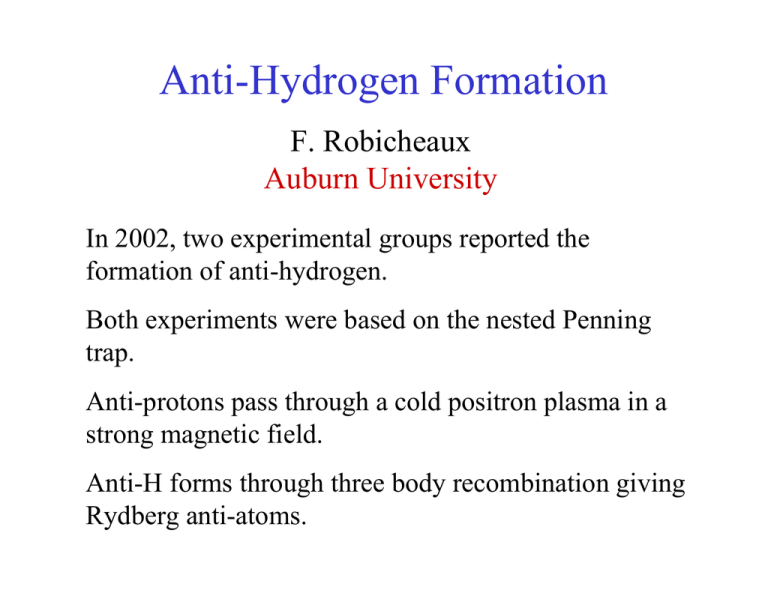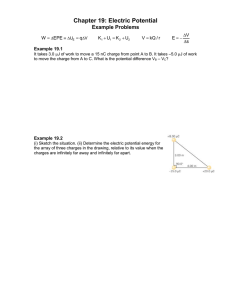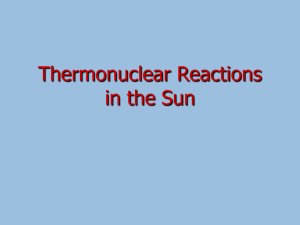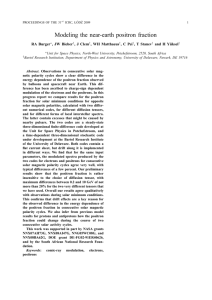Day 4
advertisement

Anti-Hydrogen Formation
F. Robicheaux
Auburn University
In 2002, two experimental groups reported the
formation of anti-hydrogen.
Both experiments were based on the nested Penning
trap.
Anti-protons pass through a cold positron plasma in a
strong magnetic field.
Anti-H forms through three body recombination giving
Rydberg anti-atoms.
Cold, Magnetized Plasmas
Two groups (ATHENA & ATRAP) attempting to make
ground state anti-hydrogen at CERN
G. Raithel group at U. of Michigan setting up experiments
to investigate cold, magnetized plasmas in matter.
Previous theoretical investigation of atomic processes
have poor approximations
Current, strong interest in atomic processes in cold,
magnetized plasmas with almost no existing calculations
Atomic processes are inherently interesting
Cold, Magnetized Plasmas
Anti-hydrogen formed from cold
plasmas of positrons and antiprotons (B > 3 T)
Goal: precision spectroscopy of
anti-hydrogen
Anti-hydrogen must be in ground
state
What are properties of antihydrogen?
Physics Today
November 2002
Where are they in the device?
Anti-Hydrogen Results (ATHENA)
See Physics Today, Nov & Dec 2002, for general info
Anti-protons pass through cold positron plasma.
Positron capture gives anti-hydrogen. Signal is
annihilation on wall of trap.
A strong magnetic field, B, along the trap keeps the
positrons and anti-protons from reaching the wall.
Atoms cross B-field and reach the wall.
Roughly 108 positrons, 104 anti-protons
Roughly 17% anti-p convert to anti-H
Rate decreases relatively slowly with T of positron plasma
Temperature &
Time Dependence
The recombination rate
decreases slowly with
heating! T-9/2????
Should be possible to
explain the ~1/2 s decay
time.
Anti-hydrogen Results (ATRAP)
Schematic
Signal
Signal from strip anti-H and capture the anti-p
Anti-H must travel ~5 cm to region where detected
Roughly 105 anti-protons and 106 positrons
Measurements
Number of anti-H vs number of positrons
Number of anti-H vs distance to detection region
Measurements
Number of anti-H vs field required to strip off positron
Gives information about the distribution of n-levels of
the atoms.
Basic Ideas (B in z-direction)
The strong magnetic field and low temperatures
strongly modify atomic processes.
A charged particle in a magnetic field B
moves in a circle with radius
r
r = m v/q B.
The period of motion is
τ = 2 π r /v = 2 π m/q B.
The angular momentum
v
L = r m v = m2 v2/q B = m kB T/q B.
At 4 K, an e- has v = (kB T/m)1/2 = 7.8 km/s.
For B = 5 Tesla
r = 8.9 nm = 168 a0,
τ = 7.1 X 10-12 s = 7.1 ps,
h/τ = 6.8 K,
L = 6.3 X 10-35 J s = 0.60 h
Conclusions
The transverse motion of the positron might need to be
quantized. Modification of scattering? (more likely to
add energy into cyclotron motion)
In a classical calculation, it is hopeless to follow the
full cyclotron motion of the positron (perhaps
symplectic propagator would help).
Positron collision processes (TBR and positronRydberg) will be strongly modified.
The anti-H will be strongly modified down to low n;
radiative decay completely changed at high n.
Guiding Center Approximation
(matter)
Charged particles spiral along magnetic field lines. If
there is a uniform and constant E-field perpendicular to
the B-field, charged particles drift perpendicular to both
fields and an average speed of E/B.
Take the charged particles position to be fixed in xy.
m az = Fz(x,y,z)
Glinsky & O’Neil used this approximation to compute
the TBR rate. Found that the rate decreased by factor of
11 from field free rate.
However, the proton cyclotron radius is roughly 7000
a.u. Might need a better approximation.
Guiding Center Approximation
The next level of approximation can allow the proton its
full motion but keep the guiding center approximation
for the electron.
vy = -Ex/B and vx = Ey/B
& =V
X
x
2
e
(X - x)
&
+ e B Vy
MVx = −
3
4 π ε0 R
& =V
Y
y
2
e
& = − (Y - y) − e B V
MV
x
y
4 π ε0 R3
Z& = Vz
2
e
(Z - z)
&
MVz = −
4 π ε0 R3
y& = −
z = vz
e (x - X)
4 π ε0 B R3
x& =
e (y - Y)
4 π ε0 B R3
e 2 (z - Z)
mv& z = −
4 π ε0 R3
Guiding Center Approximation
There are 4 constants of motion
R2 = (x – X)2 + (y – Y)2 + (z – Z)2 + c2
2
r r 1
1
e
E = M V ⋅ V + m v 2z −
2
2
4 π ε0 R
K x = MVx + (y − Y) e B
K y = MVy − (x − X) e B
Pz = MVz + m v z
When the electron is near the proton it circles with a
frequency ω = e/(4 π ε0 B R3)
Three Body Recombination
We computed the TBR rate by firing electrons randomly
at a proton. The electrons have a thermal distribution of
speeds. A recombination is determined to have occurred
when an electron is bound by > 8 kB Te.
If the region has a length L along the magnetic field, then
the probability for launching an electron during interval
P = δt (N/L) (2 kB Te/π m)1/2
m v2 = –2 kB Te ln(y) where y random 0 < y < 1
The TBR rate is the inverse of the average time to
recombination.
Three Body Recombination
Defining b = e2/(4 π ε0 kB Te) and ve = (kB Te/m)1/2, the
TBR rate can be written as
Γ= C ne2 ve b5
The field free rate has C = 0.76.
Glinsky & O’Neil (all charges pinned to field lines) found
C = 0.070 (we found 0.072 for same approximation).
The guiding center approximation gave C = 0.11 for T = 4,
8, 16 K and B = 3 and 5.4 T. Roughly 50% larger.
Transverse speed of the atoms roughly Maxwell at same T.
Dipoles small fraction of the possible size.
Only a small fraction can be stimulated to low n by photon.
Three Body Recombination
In the experiments, the anti-protons pass through the positron
gas with substantial speed. V0 = (2 kB Te/M)1/2 [V0 ~ 11 km/s
at 4 K], Vz is speed of anti-proton, E is KE of anti-proton
Vz/V0
0/6
1/6
2/6
3/6
4/6
5/6
6/6
C
0.100
0.081
0.051
0.031
0.018
0.011
0.008
E (eV)
0.00
0.04
0.14
0.32
0.56
0.88
1.27
Modeling Anti-Proton Motion
The anti-protons are launched at a potential several V
above the potential of the positron cloud. We need to
model the motion of the anti-protons through the trap.
Positron Cloud
The positrons are in thermal equilibrium in a strong
magnetic field plus the E-fields from the electrodes. The
one particle Hamiltonian is
2
2
1
qB
qB
2
H=
y + πy −
x + π z + U(x, y, z)
π x +
2 m
2
2
qB
m vx = πx +
y ....
2
The quantity πx y – πy x is a constant of the motion. The
distribution function can be written as
exp{–[H + ω (πx y – πy x)]/kB T}
The shape of the cloud is determined by ω and U.
Positron Density
The positron density is found by self consistent solution
of the equations
r
U( r ) − ω (q B + m ω) (x 2 + y 2 )/2
r
n( r ) = n 0 exp −
k
T
B
r
r
2
2
∇ U( r ) = − e n( r )/ε 0
with the condition that U/e match the potentials on the
electrodes of the trap.
In practice, these equations are solved by iteration.
At low T, n is nearly constant near the center of the
cloud D 2 ω (q B + m ω) = – e2 n(center)/ε0
Density is roughly ellipsoid
ATHENA Geometry
red-through center
orange- radius of trap/32
ATHENA Geometry
e.g.
Potential decreases proportional to ρ2 through plasma
Anti-proton period computed by integrating 1/velocity
ATHENA Geometry
Electric field shorted in positron plasma
40 V/cm can strip n ~ 55
Energy Loss By Anti-Protons
The energy of an anti-proton determines the speed in
the positron plasma. Affects TBR and final states due
to motion itself and due to duration of interaction.
Energy dumped into plasma waves.
Energy into plasma due to individual anti-proton–
positron collisions.
Stripping of weakly bound anti-hydrogen.
Stopping Power in Magnetized Plasma
Nersisyan, Walter and Zwicknagel PRE 61, 7022 (2000)
analyzed the energy lost per unit length to plasma waves
in a magnetized plasma. The expression is quite
complicated but not difficult to calculate. ∆E = ∆x dE/dx
This is energy loss to collective positron modes.
dE
2 e 2 λ2D
=−
dx
4 π 3 ε0
k max
∫ dk k
k min
3
1
2π
0
0
∫ dµ ∫ dϕ
cos(Θ) F(s)
[k 2 λ2D + G(s)]2 + F 2 (s)
s = V cos(Θ) / v th
cos(Θ) = µ cos(θ ) − 1 − µ 2 sin(θ ) cos(ϕ )
k max = 1/(scat rmin )
k min = 1 /width of plasma
∞
G(s) + i F(s) = 1 + i s 2 ∫ dt exp[i s t 2 − X(t)]
0
X(t) = ( µ t) 2 + (k a c ) 2 1 − µ 2 [1 − cos(ωc t 2 /k v th )]
Stopping Power in Magnetized Plasma
This treatment has two problems
There is only the dissipation part of the interaction. The
fluctuation part of the interaction with plasma waves is
not included. Set dE/dx to 0 when the anti-proton energy
~kB T
The collision with individual positrons not included.
This comes from the kmax. This is included by direct
solution of Newton’s equations (guiding center approx)
for random positrons fired at anti-proton.
Positron – Anti-Proton Scattering
The positron – anti-proton scattering can give a
slowing along the field and thermalization of
the cyclotron motion of the anti-proton.
The slowing along the field is a smaller effect
since the kick along the field averages to ~ 0.
The thermalization time of the cyclotron
motion is relatively rapid. For the conditions of
the anti-hydrogen experiments, the transverse
temperature is roughly that of the positrons
Positron Stripping
An anti-proton captures a positron in a region of ~ 0 Efield. When exit the plasma, experiences an E-field. If
strip the positron, the anti-proton will lose energy
∆E = -e ∆V
Strip
Strip
E lost
Positron Stripping Effect
Change in energy and x,y position:
Calculate the E-field that will strip off the positron.
Follow the anti-H in its motion outside of the plasma.
When the E-field reaches this value, find the value of
the potential using interpolation from a coarse grid of
computed values.
Save the new x,y position and energy of the anti-proton.
Plasma Heating
Anti-protons start with a few eV (1 eV ~ 1.2 X 104 K).
Slow in the plasma D the positron plasma must heat.
The plasma cools by radiation.
ATHENA: the temperature hardly changes since the
number of positrons/number of anti-protons ~ 104
ATRAP: ratio ~ 1-10. Cooling time/radiation time ~ 100.
Rise in T ~ (5 X 1.2 X 104 K/3) ~ 20-100 K in version 1
& 5-20 K in version 2
TBR Revised
The three body recombination calculations were steady
state calculations.
The experiments have the anti-protons in the positron
plasma for a short time.
At 3 km/s ~ 1/20 eV, the
anti-proton spends
0.3 mm/3 km/s = 0.1 µs
in the ATRAP geometry &
30 mm/3 km/s = 10 µs
in the ATHENA geometry.
TBR D Three Body Capture
The time in the plasma is shorter than the time for a
recombination.
The binding energy will be less than might be expected.
The ATRAP geometry particularly affected.
Preliminary Results of Simulation
3 slowing mechanisms (excitation of plasma waves,
positron/anti-p collisions, capture then strip). Solve
Newton equation for anti-p and positrons.
ATHENA
30% recombine at 15 K, 12% recombine at 30 K:
roughly correct amount of anti-H & T dependence
Motion of anti-H is highly directional
Lower T positron plasma gives more deeply bound
anti-H
Velocity of Anti-H || B
All anti-H, even those too
weak to reach the wall
Thermal
~500 m/s
For deeply
bound anti-H
½ > 4X
thermal speed
How to stop a
2 km/s anti-H?
Energy Distribution
BE = 120 K corresponds to n = 36
Preliminary Results of Simulation
ATRAP
Thin positron plasma dominates processes---capture
with ~no subsequent collisions.
Roughly 1/4000 – 1/10000 recombinations
Highly directional motion
Very weakly bound positrons
Binding Energy
Most atoms too
weakly bound to
survive trap Efields.
Relatively little
difference w/ T!
Vertical line
marks states that
survive 25 V/cm
E-field
BE = 30 K corresponds to n = 72
Comparison
ATHENA: n = 2.5 X 108 cm-3, width = 32 mm
ATRAP: n = 4 X 107 cm-3, width 0.4 mm & 1.6 mm
BE of 40 K needed to survive a 25 V/cm field
Comparison
Large fraction of the atoms have high velocity along the
B-field.
Future
Full positron-Rydberg collision, can cyclotron motion of
positron couple to motion of Rydberg positron?
Non-guiding center approximation?
Quantum mechanics of positron/anti-H collisions?
Radiation of anti-H to ground state
Suggestions for improvements (sacrifice width for
thickness!) to configuration
Evolution of ATRAP positron plasma
Can Rydbergs be driven to deeper binding?
Other anti-H formation mechanisms?



